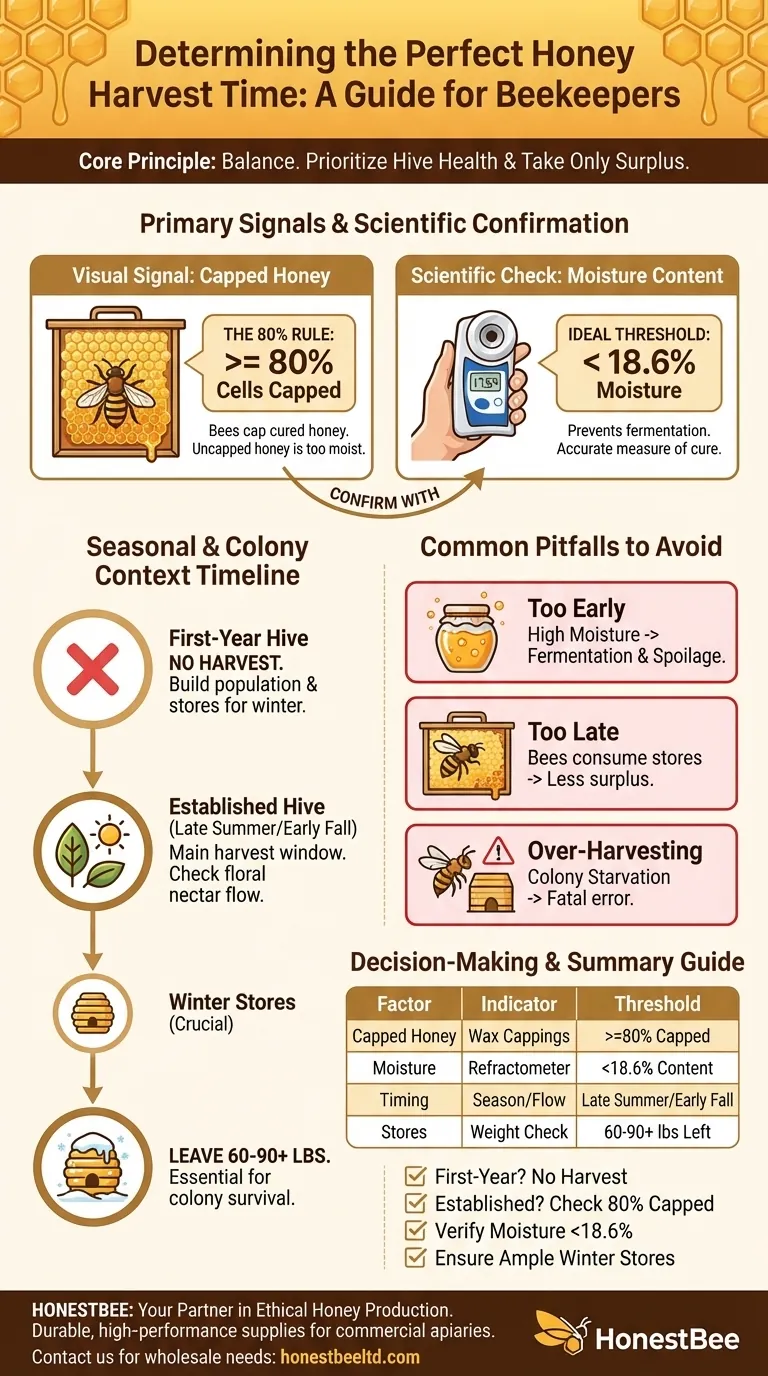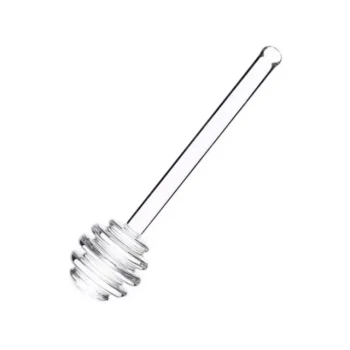The perfect time to harvest honey is determined not by a calendar date, but by clear signals from the bees themselves. Beekeepers primarily look for frames where the bees have sealed the honeycomb cells with a wax "capping," indicating the honey is cured. This visual cue is often confirmed with a tool called a refractometer to ensure the honey's moisture content is low enough to prevent fermentation.
The core principle of honey harvesting is balance. A responsible beekeeper takes only the true surplus honey, ensuring the colony has more than enough of its own food stores to survive the upcoming winter. The health of the hive always comes first.

The Primary Signal: Capped Honey
The most reliable visual indicator that honey is ready for harvest is the presence of wax cappings over the honeycomb cells.
What Capped Honey Signifies
When bees fill a cell with nectar, they fan their wings to evaporate the excess water content. Once the moisture level is just right (typically below 18.6%), they seal the cell with a fresh wax cap. This cap preserves the honey indefinitely.
The 80% Rule
A frame is generally considered ready for harvest when at least 80% of the cells on that frame are capped. The small amount of uncapped honey is usually mature enough that it will mix with the capped honey without raising the overall moisture content to a dangerous level.
The Scientific Confirmation: Moisture Content
While visual inspection is a trusted method, measuring the moisture content provides definitive proof that your honey is ready and will store properly.
Why Moisture Matters
Honey with a moisture content above 18.6% will ferment. The naturally occurring yeasts in honey will become active and begin to spoil the batch, giving it a sour, undesirable taste. Curing is the bees' natural method for preventing this.
Using a Refractometer
A honey refractometer is a simple handheld tool that measures the moisture content of a liquid. By placing a small drop of honey on the device, a beekeeper can get a precise reading and be absolutely certain the honey is ready for long-term storage.
Understanding Seasonal and Colony Context
Timing is about more than just the state of the honey; it’s about the health and age of the colony.
The First-Year Rule: Patience is Essential
A new bee colony needs its first full year to build up its population, draw out comb, and store enough honey and pollen to survive its first winter. Do not harvest honey from a first-year hive. Taking their stores is the most common and fatal mistake for new beekeepers.
General Timing: Late Summer to Early Fall
For established hives, the main harvest typically occurs at the end of the primary nectar flow. This is usually in the late summer or early fall, depending on your specific climate and local plant life.
Assessing Winter Stores
Before taking any frames, you must ensure the bees have enough food to survive the winter. A healthy colony in a cold climate may need 60-90 pounds of honey. Your primary responsibility is to leave them with more than enough to get through the lean months.
Common Pitfalls to Avoid
Understanding what can go wrong is just as important as knowing the right signals.
Harvesting Too Early
Pulling frames that are not sufficiently capped results in honey with high moisture content. This honey will ferment and spoil, ruining your entire harvest.
Harvesting Too Late
If you wait too long after the nectar flow ends, the bees will begin to consume their winter stores. Harvesting at this point means you are directly taking the food they need to survive.
Over-Harvesting
The most critical error is taking too much honey. Always err on the side of caution. Leaving an extra box of honey for the bees is far better than a colony starving to death in February.
Making the Right Choice for Your Goal
Use these points to guide your decision-making process for a successful and responsible harvest.
- If you are a first-year beekeeper: Your only goal is colony survival, so you will not harvest any honey.
- If you have an established hive: Use the 80% capped rule as your primary visual signal for which frames are ready.
- If you want to ensure the highest quality: Confirm your honey's moisture content is below 18.6% with a refractometer before extracting.
- If your priority is long-term hive health: Always verify the bees have ample winter stores before you remove any surplus frames.
Ultimately, successful honey harvesting is an act of responsible stewardship for your bees.
Summary Table:
| Key Factor | Indicator | Ideal Threshold |
|---|---|---|
| Capped Honey | Visual inspection of wax cappings | At least 80% of cells capped on a frame |
| Moisture Content | Measured with a refractometer | Below 18.6% to prevent fermentation |
| Seasonal Timing | End of primary nectar flow | Late summer to early fall for established hives |
| Colony Health | Assessment of winter food stores | Leave 60-90+ lbs of honey for the bees |
Ready for a successful, high-quality harvest?
Harvesting honey responsibly requires the right tools and knowledge. At HONESTBEE, we supply commercial apiaries and beekeeping equipment distributors with the durable, high-performance supplies needed for efficient and ethical honey production—from refractometers to full extraction systems.
Let's ensure your harvest is a sweet success. Contact our team today to discuss your wholesale needs and how we can support your operation's growth and hive health.
Visual Guide

Related Products
- 10L Stainless Steel Electric Honey Press Machine
- Stainless Steel Manual Honey Press with Guard for Pressing Honey and Wax
- Stainless Steel Honey Press Wax Press with Tank
- Electric Flatting and Embossing Machine with Tray for Beekeeping
- Honey Wax Separating Wax Press with Metal Screw Wax Separator Machine
People Also Ask
- What are the benefits of the screw design in a stainless steel honey pump? Preserve Honey Quality and Integrity
- What are the main differences between centrifugal extractors and honey presses? A Guide for Commercial Apiaries
- How does the press method for extracting honey work? A Simple, Low-Cost Guide for Beekeepers
- What are the unique characteristics of honey presses? Maximize Honey Yield for Small-Scale Beekeeping
- What are the benefits of using a honey press for Warré or Top Bar beehives? Maximize Your Natural Harvest



















